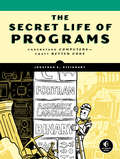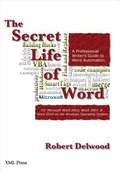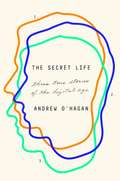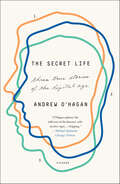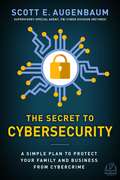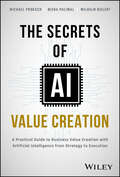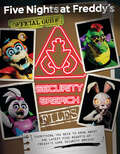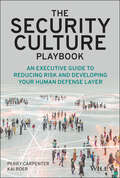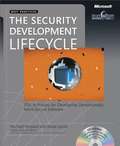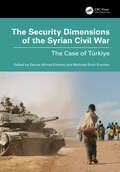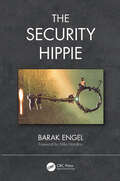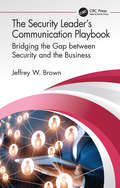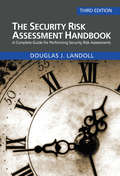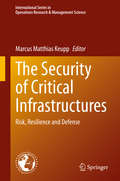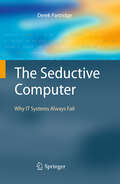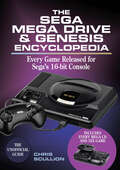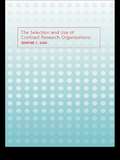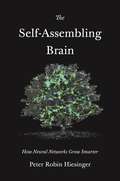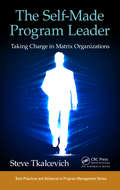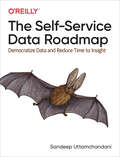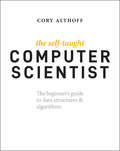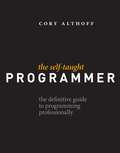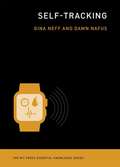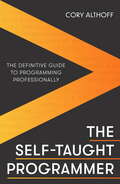- Table View
- List View
The Secret Life of Programs: Understand Computers -- Craft Better Code
by Jonathan E. SteinhartA primer on the underlying technologies that allow computer programs to work. Covers topics like computer hardware, combinatorial logic, sequential logic, computer architecture, computer anatomy, and Input/Output.Many coders are unfamiliar with the underlying technologies that make their programs run. But why should you care when your code appears to work? Because you want it to run well and not be riddled with hard-to-find bugs. You don't want to be in the news because your code had a security problem.Lots of technical detail is available online but it's not organized or collected into a convenient place. In The Secret Life of Programs, veteran engineer Jonathan E. Steinhart explores--in depth--the foundational concepts that underlie the machine. Subjects like computer hardware, how software behaves on hardware, as well as how people have solved problems using technology over time.You'll learn:How the real world is converted into a form that computers understand, like bits, logic, numbers, text, and colorsThe fundamental building blocks that make up a computer including logic gates, adders, decoders, registers, and memoryWhy designing programs to match computer hardware, especially memory, improves performanceHow programs are converted into machine language that computers understandHow software building blocks are combined to create programs like web browsersClever tricks for making programs more efficient, like loop invariance, strength reduction, and recursive subdivisionThe fundamentals of computer security and machine intelligenceProject design, documentation, scheduling, portability, maintenance, and other practical programming realities.Learn what really happens when your code runs on the machine and you'll learn to craft better, more efficient code.
The Secret Life of Word
by Robert DelwoodThe Secret Life of Word looks at Microsoft Word from the perspective of technical and other professional writers. It gives writers an in-depth look at the hidden capabilities of Word, and shows how to take advantage of those capabilities without being a programmer. The Secret Life of Word will help you master the full gamut of Word mysteries, including AutoCorrect, QuickParts, BuildingBlocks, macros, Smart Tags, program-less VBA programming, and much more. There's something here for everyone who uses Microsoft Word, from new users to experts.Inside the BookPreface Introduction to Word Automation Creating Macros Find and Replace Fields, Form Fields, and Content Controls AutoCorrect and AutoText/Building Blocks Smart Tags Exchanging Data Code Samples Automation Related Topics Glossary, Bibliography, and Index
The Secret Life: Three True Stories of the Digital Age
by Andrew O'HaganFrom the award-winning author of The Illuminations, a significant and timely work of non-fiction by one of the most important writers of his generation.Julian Assange, a man who, five years ago, seemed to herald a new, enlightened form of democracy -- until, that is, the apparent heroism of WikiLeaks became compromised by his hubris and paranoia. Satoshi Nakamoto, another man who radically reshaped the business of information and secrecy on a global scale. He is known as the elusive inventor of Bitcoin, but who is the real Satoshi -- a lone wolf or a collective of individuals with the talent to reimagine the financial wheel? And Ronald Pinn, a man who does not exist at all, except in the furthest, darkest reaches of O'Hagan's internet use. Driven by an interest in the ease with which it is possible to create an identity in an online world, O'Hagan journeys into the dark web where everything -- sex, drugs, guns -- is for sale.The Secret Life is about these elusive individuals, written in three individual yet deeply connected essays. It is a dazzling book about the porousness between genius and madness, between fact and fiction. It is about nothing less than modern personality in the digital age.
The Secret Life: Three True Stories of the Digital Age
by Andrew O'HaganAward-winning essayist and novelist Andrew O’Hagan presents a trio of reports exploring the idea of identity on the Internet—true, false, and in between—where your virtual self takes on a life of its own outside of reality.A Publishers Weekly Best Book of the Year • One of Publishers Weekly's Top 10 Book of Essays and Literary Criticism • One of Chicago Reader's Books We Can’t Wait to ReadThe Secret Life issues three bulletins from the porous border between cyberspace and IRL.“Ghosting” introduces us to the beguiling and divisive Wikileaks founder Julian Assange, whose autobiography O’Hagan agrees to ghostwrite with unforeseen—and unforgettable—consequences. “The Invention of Ronnie Pinn” finds him using the actual identity of a deceased young man to construct an entirely new one in cyberspace, leading him on a journey deep into the Web’s darkest realms. And “The Satoshi Affair” chronicles the strange case of Craig Wright, the Australian Web developer who may or may not be the mysterious inventor of Bitcoin, Satoshi Nakamoto—and who may or may not be willing, or even able, to reveal the truth.These fascinating pieces take us to the weirder fringes of life in a digital world while also casting light on our shared predicaments. What does it mean when your very sense of self becomes, to borrow a term from the tech world, “disrupted”? The Secret Life shows us that it might take a novelist, an inventor of selves, armed with the tools of a trenchant reporter, to find an answer.
The Secret Science of Ciphers
by Nick D'AltoEven if you aren't a spy, you probably already use cryptography, or the science of secret communication, every day.
The Secret to Cybersecurity: A Simple Plan to Protect Your Family and Business from Cybercrime
by Scott AugenbaumCybercrimes are a threat and as dangerous as an armed intruder—yet millions of Americans are complacent or simply uninformed of how to protect themselves. The Secret to Cybersecurity closes that knowledge gap by using real-life examples to educate readers.It’s 2 a.m.—do you know who your child is online with? According to author Scott Augenbaum, between 80 to 90 percent of students say they do whatever they want on their smartphones—and their parents don’t have a clue. Is that you? What about your online banking passwords, are they safe? Has your email account or bank/debit card ever been compromised? In 2018, there were data breaches at several major companies—If those companies have your credit or debit information, that affects you. There are bad people in the world, and they are on the internet. They want to hurt you. They are based all over the world, so they’re hard at “work” when even you’re sleeping. They use automated programs to probe for weaknesses in your internet security programs. And they never stop. Cybercrime is on the increase internationally, and it’s up to you to protect yourself. But how? The Secret to Cybersecurity is the simple and straightforward plan to keep you, your family, and your business safe. Written by Scott Augenbaum, a 29-year veteran of the FBI who specialized in cybercrimes, it uses real-life examples to educate and inform readers, explaining who/why/how so you’ll have a specific takeaway to put into action for your family. Learn about the scams, methods, and ways that cyber criminals operate—and learn how to avoid being the next cyber victim.
The Secrets of AI Value Creation: A Practical Guide to Business Value Creation with Artificial Intelligence from Strategy to Execution
by Wilhelm Bielert Michael Proksch Nisha PaliwalUnlock unprecedented levels of value at your firm by implementing artificial intelligence In The Secrets of AI Value Creation: Practical Guide to Business Value Creation with Artificial Intelligence from Strategy to Execution, a team of renowned artificial intelligence leaders and experts delivers an insightful blueprint for unlocking the value of AI in your company. This book presents a comprehensive framework that can be applied to your organisation, exploring the value drivers and challenges you might face throughout your AI journey. You will uncover effective strategies and tactics utilised by successful artificial intelligence (AI) achievers to propel business growth. In the book, you’ll explore critical value drivers and key capabilities that will determine the success or failure of your company’s AI initiatives. The authors examine the subject from multiple perspectives, including business, technology, data, algorithmics, and psychology. Organized into four parts and fourteen insightful chapters, the book includes: Concrete examples and real-world case studies illustrating the practical impact of the ideas discussed within Best practices used and common challenges encountered when first incorporating AI into your company’s operations A comprehensive framework you can use to navigate the complexities of AI implementation and value creation An indispensable blueprint for artificial intelligence implementation at your organisation, The Secrets of AI Value Creation is a can’t-miss resource for managers, executives, directors, entrepreneurs, founders, data analysts, and business- and tech-side professionals looking for ways to unlock new forms of value in their company. The authors, who are industry leaders, assemble the puzzle pieces into a comprehensive framework for AI value creation: Michael Proksch is an expert on the subject of AI strategy and value creation. He worked with various Fortune 2000 organisations and focuses on optimising business operations building customised AI solutions, and driving organisational adoption of AI through the creation of value and trust. Nisha Paliwal is a senior technology executive. She is known for her expertise in various technology services, focusing on the importance of bringing AI technology, computing resources, data, and talent together in a synchronous and organic way. Wilhelm Bielert is a seasoned senior executive with an extensive of experience in digital transformation, program and project management, and corporate restructuring. With a proven track record, he has successfully led transformative initiatives in multinational corporations, specialising in harnessing the power of AI and other cutting-edge technologies to drive substantial value creation.
The Security Breach Files: An AFK Book (Five Nights At Freddy's)
by Scott CawthonEverything fans will want to know about the newest Five Night's at Freddy's game "Security Breach", in a deluxe hardcover!A deep dive into the newest Five Nights at Freddy's game is presented here in a giant hardcover that will make the perfect addition to any fan’s library. From the newest animatronics to the deepest maps and easter eggs, everything is laid out in awesome detail that will deepen the knowledge of even the most enthusiastic player. A must-have for Freddy Fans!
The Security Culture Playbook: An Executive Guide To Reducing Risk and Developing Your Human Defense Layer
by Perry Carpenter Kai RoerMitigate human risk and bake security into your organization&’s culture from top to bottom with insights from leading experts in security awareness, behavior, and culture. The topic of security culture is mysterious and confusing to most leaders. But it doesn&’t have to be. In The Security Culture Playbook, Perry Carpenter and Kai Roer, two veteran cybersecurity strategists deliver experience-driven, actionable insights into how to transform your organization&’s security culture and reduce human risk at every level. This book exposes the gaps between how organizations have traditionally approached human risk and it provides security and business executives with the necessary information and tools needed to understand, measure, and improve facets of security culture across the organization. The book offers: An expose of what security culture really is and how it can be measured A careful exploration of the 7 dimensions that comprise security culture Practical tools for managing your security culture program, such as the Security Culture Framework and the Security Culture Maturity Model Insights into building support within the executive team and Board of Directors for your culture management programAlso including several revealing interviews from security culture thought leaders in a variety of industries, The Security Culture Playbook is an essential resource for cybersecurity professionals, risk and compliance managers, executives, board members, and other business leaders seeking to proactively manage and reduce risk.
The Security Development Lifecycle: A Process for Developing Demonstrably More Secure Software
by Michael Howard Steve Lipner<div xmlns="http://www.w3.org/1999/xhtml"><p>With expert insights, this introduction to the Security Development Lifecycle (SDL) provides you with a history of the methodology and guides you through each stage of the proven process\u2014from design to release\u2014that helps minimize security defects.</p></div>
The Security Dimensions of the Syrian Civil War: The Case of Türkiye (Security, Audit and Leadership Series)
by Mehmet Emin Erendor Serhat Ahmet ErkmenSyria's bloody civil war has plunged the cradle of the Levant into a painful spiral of violence. This spiral of violence has caused profound social, political, economic, and strategic changes in Syria. But the effects of the civil war are not limited to Syria. The civil war in Syria has become a direct problem not only for Syria but also for Türkiye, Iraq, Lebanon, and Jordan. However, most observers agree that of all Syria's neighbors, Türkiye has been the most affected by the civil war.When one thinks of Türkiye and Syria together in recent years, two concepts come to mind most often: Military operations and migration. However, conflicts in Syria have been perceived in a broader security paradigm in Türkiye.The main topics of the book can be summarized as follows: Border issues, sovereignty disputes, alliances, and military interventions in Türkiye–Syria relations. The effects of the civil war in Syria on Türkiye's foreign policy, economy, social structure, and internal security. Reflections of the civil war on Türkiye's relations with Iran, the US, and Russia. Increasing separatist and radical Salafist terrorism in Türkiye in line with the spillover effect of civil wars. Cross-border operations and Türkiye's military capacity. The problem of migration. Within the framework of the topics addressed, the book provides a comprehensive reading of the security problems caused by the Syrian Civil War on Türkiye. We believe that this book will shed light on why Türkiye perceives what is happening in Syria from a security perspective. In fact, the main idea of the book is simple: Syria has been a security issue for Türkiye since the 1930s, and it is still a security issue now. After approximately 100 years, the main idea has not changed. The only thing that has changed is how security is defined.
The Security Hippie (Security, Audit and Leadership Series)
by Barak EngelThe Security Hippie is Barak Engel’s second book. As the originator of the “Virtual CISO” (fractional security chief) concept, he has served as security leader in dozens of notable organizations, such as Mulesoft, Stubhub, Amplitude Analytics, and many others. The Security Hippie follows his previous book, Why CISOs Fail, which became a sleeper hit, earning a spot in the Cybercannon project as a leading text on the topic of information security management. In this new book, Barak looks at security purely through the lens of story-telling, sharing many and varied experiences from his long and accomplished career as organizational and thought leader, and visionary in the information security field. Instead of instructing, this book teaches by example, sharing many real situations in the field and actual events from real companies, as well as Barak’s related takes and thought processes. An out-of-the-mainstream, counterculture thinker – Hippie – in the world of information security, Barak’s rich background and unusual approach to the field come forth in this book in vivid color and detail, allowing the reader to sit back and enjoy these experiences, and perhaps gain insights when faced with similar issues themselves or within their organizations. The author works hard to avoid technical terms as much as possible, and instead focus on the human and behavioral side of security, finding the humor inherent in every anecdote and using it to demystify the field and connect with the reader. Importantly, these are not the stories that made the news; yet they are the ones that happen all the time. If you’ve ever wondered about the field of information security, but have been intimidated by it, or simply wished for more shared experiences, then The Security Hippie is the perfect way to open that window by accompanying Barak on some of his many travels into the land of security.
The Security Leader’s Communication Playbook: Bridging the Gap between Security and the Business (Internal Audit And It Audit Ser.)
by Jeffrey W. BrownThis book is for cybersecurity leaders across all industries and organizations. It is intended to bridge the gap between the data center and the board room. This book examines the multitude of communication challenges that CISOs are faced with every day and provides practical tools to identify your audience, tailor your message and master the art of communicating. Poor communication is one of the top reasons that CISOs fail in their roles. By taking the step to work on your communication and soft skills (the two go hand-in-hand), you will hopefully never join their ranks. This is not a “communication theory” book. It provides just enough practical skills and techniques for security leaders to get the job done. Learn fundamental communication skills and how to apply them to day-to-day challenges like communicating with your peers, your team, business leaders and the board of directors. Learn how to produce meaningful metrics and communicate before, during and after an incident. Regardless of your role in Tech, you will find something of value somewhere along the way in this book.
The Security Risk Assessment Handbook: A Complete Guide for Performing Security Risk Assessments
by Douglas LandollConducted properly, information security risk assessments provide managers with the feedback needed to manage risk through the understanding of threats to corporate assets, determination of current control vulnerabilities, and appropriate safeguards selection. Performed incorrectly, they can provide the false sense of security that allows potential threats to develop into disastrous losses of proprietary information, capital, and corporate value. Picking up where its bestselling predecessors left off, The Security Risk Assessment Handbook: A Complete Guide for Performing Security Risk Assessments, Third Edition gives you detailed instruction on how to conduct a security risk assessment effectively and efficiently, supplying wide-ranging coverage that includes security risk analysis, mitigation, and risk assessment reporting. The third edition has expanded coverage of essential topics, such as threat analysis, data gathering, risk analysis, and risk assessment methods, and added coverage of new topics essential for current assessment projects (e.g., cloud security, supply chain management, and security risk assessment methods). This handbook walks you through the process of conducting an effective security assessment, and it provides the tools, methods, and up-to-date understanding you need to select the security measures best suited to your organization. Trusted to assess security for small companies, leading organizations, and government agencies, including the CIA, NSA, and NATO, Douglas J. Landoll unveils the little-known tips, tricks, and techniques used by savvy security professionals in the field. It includes features on how to Better negotiate the scope and rigor of security assessments Effectively interface with security assessment teams Gain an improved understanding of final report recommendations Deliver insightful comments on draft reports This edition includes detailed guidance on gathering data and analyzes over 200 administrative, technical, and physical controls using the RIIOT data gathering method; introduces the RIIOT FRAME (risk assessment method), including hundreds of tables, over 70 new diagrams and figures, and over 80 exercises; and provides a detailed analysis of many of the popular security risk assessment methods in use today. The companion website (infosecurityrisk.com) provides downloads for checklists, spreadsheets, figures, and tools.
The Security of Critical Infrastructures: Risk, Resilience and Defense (International Series in Operations Research & Management Science #288)
by Marcus Matthias KeuppThis book analyzes the security of critical infrastructures such as road, rail, water, health, and electricity networks that are vital for a nation’s society and economy, and assesses the resilience of these networks to intentional attacks. The book combines the analytical capabilities of experts in operations research and management, economics, risk analysis, and defense management, and presents graph theoretical analysis, advanced statistics, and applied modeling methods. In many chapters, the authors provide reproducible code that is available from the publisher’s website. Lastly, the book identifies and discusses implications for risk assessment, policy, and insurability. The insights it offers are globally applicable, and not limited to particular locations, countries or contexts. Researchers, intelligence analysts, homeland security staff, and professionals who operate critical infrastructures will greatly benefit from the methods, models and findings presented. While each of the twelve chapters is self-contained, taken together they provide a sound basis for informed decision-making and more effective operations, policy, and defense.
The Seductive Computer
by Derek PartridgeIT systems explode budget estimates, bust production deadlines by years, and then fail to work properly. Why this IT-system crisis? Poor programmers? Inadequate project management? No. The Seductive Computer argues that the fundamental nature of programming technology itself is the real culprit; it promises perfection but can only deliver emergent chaos. It is also an insidiously compelling technology, peculiarly male oriented. IT systems, an unavoidable and increasing reality in all our lives, are something new to man - large-scale discrete complexity. The Seductive Computer explains this novelty that defies human understanding. This book illustrates in a simple yet thorough manner the underlying concepts necessary for understanding the IT-system crisis - not 'How To Program' but what the demands of programming are. It then proceeds to lay out the full gamut of issues - all stemming from the nature of the technology. From development to maintenance IT-system personnel are grappling with incipient chaos. The technicians are seduced by the detailed challenge of the technology. The scientists are seduced by the promises of their technology. The managers and users are seduced by the mysteries of the technology. No IT system is ever fully understood by anyone, so surprising behaviours will always emerge. What can be done? We must rein in our expectations of IT systems: what they can do, and how reliably they can do it. On the positive side, The Seductive Computer discusses novel paradigms that look beyond the current discrete technology: neural computing and precise approximation computing.
The Sega Mega Drive & Genesis Encyclopedia: Every Game Released for Sega's 16-bit Console
by Chris Scullion“An exhaustive, tremendous look back at one of the most beloved consoles of all time . . . an absolutely barnstorming recollection of a wonderful era.” —Finger GunsThe third book in Chris Scullion’s series of video game encyclopedias, The Sega Mega Drive and Genesis Encyclopedia is dedicated to Sega’s legendary 16-bit video game console. The book contains detailed information on every single game released for the Sega Mega Drive and Genesis in the west, as well as similarly thorough bonus sections covering every game released for its add-ons, the Mega CD and 32X. With nearly a thousand screenshots, generous helpings of bonus trivia and charmingly bad jokes, The Sega Mega Drive and Genesis Encyclopedia is the definitive guide to a legendary gaming system.“The Sega Mega Drive and Genesis Encyclopedia is a must-buy for fans of the console and a perfect addition to any retro game fan’s library.” —Goomba Stomp Magazine
The Selection and Use of Contract Research Organizations: A Guide For The Pharmaceutical And Medical Device Industries
by Shayne C. GadChoosing the right contract research organization (CRO) can make the difference between getting a product to market quickly and cost-effectively, and wasting valuable time and money. The vast number of available CROs is increasing all the time, and all of them make impressive claims. The Selection and Use of Contract Research Organizations is your
The Self-Assembling Brain: How Neural Networks Grow Smarter
by Peter Robin HiesingerWhat neurobiology and artificial intelligence tell us about how the brain builds itself How does a neural network become a brain? While neurobiologists investigate how nature accomplishes this feat, computer scientists interested in artificial intelligence strive to achieve this through technology. The Self-Assembling Brain tells the stories of both fields, exploring the historical and modern approaches taken by the scientists pursuing answers to the quandary: What information is necessary to make an intelligent neural network?As Peter Robin Hiesinger argues, “the information problem” underlies both fields, motivating the questions driving forward the frontiers of research. How does genetic information unfold during the years-long process of human brain development—and is there a quicker path to creating human-level artificial intelligence? Is the biological brain just messy hardware, which scientists can improve upon by running learning algorithms on computers? Can AI bypass the evolutionary programming of “grown” networks? Through a series of fictional discussions between researchers across disciplines, complemented by in-depth seminars, Hiesinger explores these tightly linked questions, highlighting the challenges facing scientists, their different disciplinary perspectives and approaches, as well as the common ground shared by those interested in the development of biological brains and AI systems. In the end, Hiesinger contends that the information content of biological and artificial neural networks must unfold in an algorithmic process requiring time and energy. There is no genome and no blueprint that depicts the final product. The self-assembling brain knows no shortcuts.Written for readers interested in advances in neuroscience and artificial intelligence, The Self-Assembling Brain looks at how neural networks grow smarter.
The Self-Made Program Leader: Taking Charge in Matrix Organizations (Best Practices in Portfolio, Program, and Project Management #21)
by Steve TkalcevichAlmost all leadership books assume that the leader has authority over their team members. The challenge of project management in a matrix-structured environment is that this is not always the case. A whole new plan of attack has to be executed for the project manager to deliver in an organization where they do not have formal authority. This book t
The Self-Service Data Roadmap: Democratize Data And Reduce Time To Insight
by Sandeep UttamchandaniData-driven insights are a key competitive advantage for any industry today, but deriving insights from raw data can still take days or weeks. Most organizations can’t scale data science teams fast enough to keep up with the growing amounts of data to transform. What’s the answer? Self-service data.With this practical book, data engineers, data scientists, and team managers will learn how to build a self-service data science platform that helps anyone in your organization extract insights from data. Sandeep Uttamchandani provides a scorecard to track and address bottlenecks that slow down time to insight across data discovery, transformation, processing, and production. This book bridges the gap between data scientists bottlenecked by engineering realities and data engineers unclear about ways to make self-service work.Build a self-service portal to support data discovery, quality, lineage, and governanceSelect the best approach for each self-service capability using open source cloud technologiesTailor self-service for the people, processes, and technology maturity of your data platformImplement capabilities to democratize data and reduce time to insightScale your self-service portal to support a large number of users within your organization
The Self-Taught Computer Scientist: The Beginner's Guide to Data Structures & Algorithms
by Cory AlthoffThe Self-Taught Computer Scientist is Cory Althoff's follow-up to The Self-Taught Programmer, which inspired hundreds of thousands of professionals to learn how to program outside of school. In The Self-Taught Programmer, Cory showed readers why you don't need a computer science degree to program professionally and taught the programming fundamentals he used to go from a complete beginner to a software engineer at eBay without one. In The Self-Taught Computer Scientist, Cory teaches you the computer science concepts that all self-taught programmers should understand to have outstanding careers. The Self-Taught Computer Scientist will not only make you a better programmer; it will also help you pass your technical interview: the interview all programmers have to pass to land a new job. Whether you are preparing to apply for jobs or sharpen your computer science knowledge, reading The Self-Taught Computer Scientist will improve your programming career. It's written for complete beginners, so you should have no problem reading it even if you've never studied computer science before.
The Self-Taught Programmer: The Definitive Guide to Programming Professionally, 1st Edition
by Cory AlthoffI am a self-taught programmer. After a year of self-study, I learned to program well enough to land a job as a software engineer II at eBay. Once I got there, I realized I was severely under-prepared. I was overwhelmed by the amount of things I needed to know but hadn't learned yet. My journey learning to program, and my experience at my first job as a software engineer were the inspiration for this book. <P><P>This book is not just about learning to program; although you will learn to code. If you want to program professionally, it is not enough to learn to code; that is why, in addition to helping you learn to program, I also cover the rest of the things you need to know to program professionally that classes and books don't teach you. "The Self-taught Programmer" is a roadmap, a guide to take you from writing your first Python program, to passing your first technical interview. I divided the book into five sections: <P><P> 1. Learn to program in Python 3 and build your first program. </br> 2. Learn Object-oriented programming and create a powerful Python program to get you hooked. </br> 3. Learn to use tools like Git, Bash, regular expressions and databases. Then use your new coding skills to build a web scraper. </br> 4. Study Computer Science fundamentals like data structures and algorithms.</br> 5. Finish with tips for working with a team and landing a programming job. <P><P>You CAN learn to program professionally. The path is there. Will you take it?
The Self-Tracking
by Gina Neff Dawn NafusPeople keep track. In the eighteenth century, Benjamin Franklin kept charts of time spent and virtues lived up to. Today, people use technology to self-track: hours slept, steps taken, calories consumed, medications administered. Ninety million wearable sensors were shipped in 2014 to help us gather data about our lives. This book examines how people record, analyze, and reflect on this data, looking at the tools they use and the communities they become part of. Gina Neff and Dawn Nafus describe what happens when people turn their everyday experience -- in particular, health and wellness-related experience -- into data, and offer an introduction to the essential ideas and key challenges of using these technologies. They consider self-tracking as a social and cultural phenomenon, describing not only the use of data as a kind of mirror of the self but also how this enables people to connect to, and learn from, others.Neff and Nafus consider what's at stake: who wants our data and why; the practices of serious self-tracking enthusiasts; the design of commercial self-tracking technology; and how self-tracking can fill gaps in the healthcare system. Today, no one can lead an entirely untracked life. Neff and Nafus show us how to use data in a way that empowers and educates.
The Self-taught Programmer: The Definitive Guide to Programming Professionally
by Cory Althoff'One of the best software design books of all time' - BookAuthorityCory Althoff is a self-taught programmer. After a year of self-study, he learned to program well enough to land a job as a software engineer II at eBay. But once he got there, he realised he was severely under-prepared. He was overwhelmed by the amount of things he needed to know but hadn't learned. His journey learning to program, and his experience in first software engineering job were the inspiration for this book. This book is not just about learning to program, although you will learn to code. If you want to program professionally, it is not enough to learn to code; that is why, in addition to helping you learn to program, Althoff also cover the rest of the things you need to know to program professionally that classes and books don't teach you. The Self-taught Programmer is a roadmap, a guide to take you from writing your first Python program to passing your first technical interview. The book is divided into five sections: 1. Learn to program in Python 3 and build your first program. 2. Learn object-oriented programming and create a powerful Python program to get you hooked. 3. Learn to use tools like Git, Bash and regular expressions. Then use your new coding skills to build a web scraper. 4. Study computer science fundamentals like data structures and algorithms. 5. Finish with best coding practices, tips for working with a team and advice on landing a programming job.You can learn to program professionally. The path is there. Will you take it?From the authorI spent one year writing The Self-Taught Programmer. It was an exciting and rewarding experience. I treated my book like a software project. After I finished writing it, I created a program to pick out all of the code examples from the book and execute them in Python to make sure all 300+ examples worked properly. Then I wrote software to add line numbers and color to every code example. Finally, I had a group of 200 new programmers 'beta read' the book to identify poorly explained concepts and look for any errors my program missed. I hope you learn as much reading my book as I did writing it. Best of luck with your programming!
